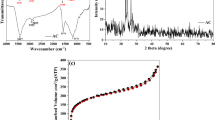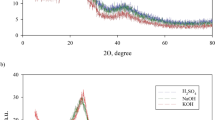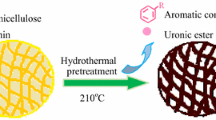Abstract
This study was undertaken to synthesise a novel biomass-based chemically activated carbon from Australian pine cone and to investigate its effectiveness in the removal of anionic dye Congo red from aqueous solution. The effect of activation parameters such as the concentration of phosphoric acid and temperature were identified as the most efficient parameters for activation in the Congo red removal. The synthesised activated carbon was characterised by Fourier transform infrared and different physical properties, such as bulk density, CHNS analysis, carbon yield, particle size, zeta potential and Brunauer–Emmett–Teller surface area were also determined. Batch adsorption study showed that the amount of adsorption depends on various physico-chemical process parameters, such as solution pH, dye concentration, temperature and adsorbent dose. It was observed that Langmuir maximum adsorption capacity was 500 mg/g at a pH of 3.5. Furthermore, pseudo-first-order, pseudo-second-order, Elovich and intra-particle diffusion models were fitted to examine the adsorption kinetic and mechanism of adsorption. Equilibrium data were fitted with Langmuir, Freundlich and Tempkin adsorption isotherm models. Thermodynamic parameters such as ΔG0, ΔH0, and ΔS0 were also calculated. Finally, a single-stage batch adsorber design for the Congo red adsorption onto activated carbon particles was presented based on the Freundlich isotherm model equation. These results indicated pine cone biomass is a good and cheap precursor for the production of an effective activated carbon adsorbent and alternative to commercial-activated carbon.










Similar content being viewed by others
References
Ahmad, R., & Kumar, R. (2010). Adsorptive removal of Congo red dye from aqueous solution using bael shell carbon. Applied Surface Science, 257, 1628–1633.
Aksakal, O., & Ucun, H. (2010). Equilibrium, kinetic and thermodynamic studies of the biosorption of textile dye (Reactive Red 195) onto Pinus sylvestris L. Journal of Hazardous Materials, 181, 666–672.
Arias, F., & Sen, T. K. (2009). Removal of zinc metal ion (Zn2+) from its aqueous solution by kaolin clay mineral: a kinetic and equilibrium study. Colloids and Surfaces A: Physicochemical and Engineering Aspects, 348, 100–108.
Auta, M., & Hameed, B. H. (2013). Coalesced chitosan activated carbon composite for batch and fixed-bed adsorption of cationic and anionic dyes. Colloids and Surfaces B: Biointerfaces, 105, 199–206.
Bhattacharyya, K., & Sharma, A. (2005). Kinetics and thermodynamics of methylene blue adsorption on neem leaf powder. Dyes and Pigments, 66, 51–59.
Binupriya, A. R., Sathishkumar, M., Swaminathan, K., Ku, C. S., & Yun, S. E. (2008). Comparative studies on removal of Congo red by native and modified mycelial pellets of Trametes versicolor in various reactor modes. Bioresource Technology, 99, 1080–1088.
Chen, H., & Zhao, J. (2009). Adsorption study for removal of Congo red anionic dye using organo-attapulgite. Adsorption, 15, 381–389.
Dawood, S., & Sen, T. K. (2012). Removal of anionic dye Congo red from aqueous solution by raw pine and acid-treated pine cone powder as adsorbent: equilibrium, thermodynamic, kinetics, mechanism and process design. Water Research, 46, 1933–1946.
Doğan, M., Alkan, M., Türkyilmaz, A., & Özdemir, Y. (2004). Kinetics and mechanism of removal of methylene blue by adsorption onto perlite. Journal of Hazardous Materials, 109, 141–148.
EI-Latif, M. M. A., Ibrahim, A. M., & EI-Kady, M. F. (2010). Adsorption equilibrium, kinetics and thermodynamics of methylene blue from aqueous solutions using biopolymer oak sawdust composite. American Journal of Science, 6, 267–283.
Fathy, N.A., Ahmed, S.A.S., El-enin, R.M.M.A., (2012). Effect of activation temperature on textural and adsorptive properties for activated carbon derived from local reed biomass: removal of p-nitrophenol. Environmental Research, Engineering and Management 59.
Foo, K. Y., & Hameed, B. H. (2011). Microwave assisted preparation of activated carbon from pomelo skin for the removal of anionic and cationic dyes. Chemical Engineering Journal, 173, 385–390.
Freundlich, H.M.F., (1906). Über die adsorption in lösungen. Z. Phys. Chem., Stoechiom 57(A) 385–471
Ghaedi, M., Tavallali, H., Sharifi, M., Kokhdan, S. N., & Asghari, A. (2012). Preparation of low cost activated carbon from Myrtus communis and pomegranate and their efficient application for removal of Congo red from aqueous solution. Spectrochimica Acta Part A: Molecular and Biomolecular Spectroscopy, 86, 107–114.
Gómez, V., Larrechi, M. S., & Callao, M. P. (2007). Kinetic and adsorption study of acid dye removal using activated carbon. Chemosphere, 69, 1151–1158.
Ho, Y.-S., & McKay, G. (1999). Pseudo-second order model for sorption processes. Process Biochemistry, 34(5), 451–465.
Kaur, S., Rani, S., & Mahajan, R. K. (2013). Adsorption kinetics for the removal of hazardous dye Congo red by biowaste materials as adsorbents. Australian Journal of Chemistry, 2013, 12.
Kong, H., He, J., Gao, Y., Han, J., & Zhu, X. (2011). Removal of polycyclic aromatic hydrocarbons from aqueous solution on soybean stalk-based carbon. Journal of Environmental Quality, 40, 1737–1744.
Kumar, P., Ramalingam, S., Senthamarai, C., Niranjanaa, M., Vijayalakshmi, P., & Sivanesan, S. (2010). Adsorption of dye from aqueous solution by cashew nut shell: studies on equilibrium isotherm, kinetics and thermodynamics of interactions. Desalination, 261, 52–60.
Lagergren, S. (1898). About the theory of so-called adsorption of soluble substances. Kungliga Svenska Vetenskapsakademiens Handlingar, 24, 1–39.
Langmuir, I. (1916). The constitution and fundamental properties of solids and liquids. Part I. Solids. The Journal of the American Chemical Society, 38, 2221–2295.
Mane, V. S., & Vijay Babu, P. V. (2013). Kinetic and equilibrium studies on the removal of Congo red from aqueous solution using Eucalyptus wood (Eucalyptus globulus) saw dust. Journal of the Taiwan Institute of Chemical Engineers, 44, 81–88.
Milonjić, S. K. (2007). A consideration of the correct calculation of thermodynamic parameters of adsorption. Journal of the Serbian Chemical Society, 72, 1363–1367.
Ofomaja, A. E., Naidoo, E. B., & Modise, S. J. (2010). Biosorption of copper(II) and lead(II) onto potassium hydroxide treated pine cone powder. Journal of Environmental Management, 91, 1674–1685.
Patel, H., & Vashi, R. T. (2012). Removal of Congo red dye from its aqueous solution using natural coagulants. Journal of Saudi Chemical Society, 16.
Poinern, G. E. J., Senanayake, G., Shah, N., Thi-Le, X. N., Parkinson, G. M., & Fawcett, D. (2011). Adsorption of the aurocyanide, complex on granular activated carbons derived from macadamia nut shells—a preliminary study. Minerals Engineering, 24, 1694–1702.
Purkait, M. K., Maiti, A., DasGupta, S., & De, S. (2007). Removal of Congo red using activated carbon and its regeneration. Journal of Hazardous Materials, 145, 287–295.
Reddy, K. S. K., Al Shoaibi, A., & Srinivasakannan, C. (2012). A comparison of microstructure and adsorption characteristics of activated carbons by CO2 and H3PO4 activation from date palm pits. New Carbon Materials, 27, 344–351.
Roginsky, S.Z., Zeldovich, J., (1934). Acta Physicochim. USSR, 554.
Salame, I. I., & Bandosz, T. J. (2001). Surface chemistry of activated carbons: combining the results of temperature-programmed desorption, boehm, and potentiometric titrations. Journal of Colloid and Interface Science, 240, 252–258.
Salleh, M. A. M., Mahmoud, D. K., Karim, W. A., & Idris, A. (2011). Cationic and anionic dye adsorption by agricultural solid wastes: a comprehensive review. Desalination, 280, 1–13.
Sen, T. K., Afroze, S., & Ang, H. M. (2011). Equilibrium, kinetics and mechanism of removal of methylene blue from aqueous solution by adsorption onto pine cone biomass of Pinus radiata. Water, Air, and Soil Pollution, 218, 499–515.
Shi, Q., Zhang, J., Zhang, C., Li, C., Zhang, B., Hu, W., et al. (2010). Preparation of activated carbon from cattail and its application for dyes removal. Journal of Environmental Sciences, 22, 91–97.
Singh, K., & Arora, S. (2011). Removal of synthetic textile dyes from wastewaters: a critical review on present treatment technologies. Critical Reviews in Environmental Science and Technology, 41, 807–878.
Sreelatha, G., Ageetha, V., Parmar, J., & Padmaja, P. (2011). Equilibrium and kinetic studies on reactive dye adsorption using palm shell powder and chitosan. Journal of Chemical and Engineering Data, 56, 35–42.
Sugumaran, P., Susan, V. P., Ravichandran, P., & Seshadri, S. (2012). Production and characterization of activated carbon from banana empty fruit bunch and Delonix regia fruit pod. Journal of Sustainable & Energy Environment, 3, 125–132.
Tay, T., Ucar, S., & Karagöz, S. (2009). Preparation and characterization of activated carbon from waste biomass. Journal of Hazardous Materials, 165, 481–485.
Vadivelan, V., & Kumar, K. V. (2005). Equilibrium, kinetics, mechanism and process design for the sorption of methylene blue onto rice husk. Journal of Colloid and Interface Science, 286, 90–100.
Vimonses, V., Lei, S., Jin, B., Chow, C. W. K., & Saint, C. (2009). Kinetic study and equilibrium isotherm analysis of Congo red adsorption by clay materials. Chemical Engineering Journal, 148, 354.
Yin, C. Y., Aroua, M. K., & Daud, W. M. A. W. (2007). Impregnation of palm shell activated carbon with polyethyleneimine and its effects on Cd2+ adsorption. Colloids and Surfaces A: Physicochemical and Engineering Aspects, 307, 128–136.
Acknowledgements
The authors would like to thank the Chemical Engineering Department of Curtin University-Perth for financial support, Chemical Engineering Laboratory Technicians.
Author information
Authors and Affiliations
Corresponding author
Rights and permissions
About this article
Cite this article
Dawood, S., Sen, T.K. & Phan, C. Synthesis and Characterisation of Novel-Activated Carbon from Waste Biomass Pine Cone and Its Application in the Removal of Congo Red Dye from Aqueous Solution by Adsorption. Water Air Soil Pollut 225, 1818 (2014). https://doi.org/10.1007/s11270-013-1818-4
Received:
Accepted:
Published:
DOI: https://doi.org/10.1007/s11270-013-1818-4




